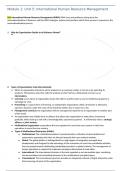Samenvatting
Summary BDO319 Module 1 Unit 5: International HRM
- Vak
- Instelling
This document highlights the types of HRM, why it business is done overseas and why it is done elsewhere. The different forms of international approaches to expatriates is discussed alongside the types of international assignments.
[Meer zien]




